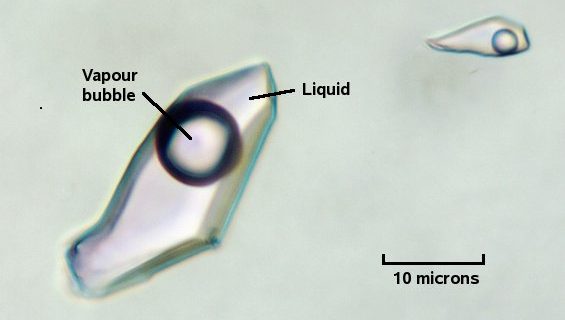
By
Hailey Berry
December 2022
Print Version
What you need to know
Fluid inclusions are small drops of fluid trapped in a mineral when they first form or when the host mineral fractures. The fluid trapped can be liquid, vapour, or supercritical fluid (solid). Fluid inclusion studies allow us to better understand ore-forming processes in hydrothermal systems. The fluid inclusions present in minerals provide information about temperatures, pressures, and fluid compositions of ore deposits.
This study looks at the fluid properties of the Bonanza base metal hydrothermal system in the Northwest Territories and compares them to other systems to determine the potential source of the hydrothermal fluids.
Why this research is important
One of the best ways to determine the formation temperature of a hydrothermal ore deposit is by fluid inclusions studies. The homogenization temperature is the temperature at which the fluid is trapped within the mineral. It records the temperature at which the mineral formed. Different deposit types form at different temperatures. Epithermal deposits typically form at shallow depths <1.5km and temperatures <300˚C. Homogenization temperatures for epithermal deposits range from <100 to >450 ˚C. Porphyry copper systems have homogenization temperatures ranging from 100 to >600 ˚C. Porphyry copper deposits form from hydrothermal fluids that come from a magma chamber below the copper deposit. Understanding the deposit type can aid in finding ore deposits which is important from an economic point of view.
Multiple studies have been done on hydrothermal systems to determine the formation temperature based on fluid inclusion data. This data can be used to compare ore deposits to determine how they compare or differ.
How this research was conducted
Thirty rock samples were collected from outcrops by Dr. Ali Somarin during an advanced exploration project in the Great Bear Magmatic Zone in the Northwest Territories. From those rock samples, thin sections were made. Fluid inclusions were found in eight thin sections and analyzed using a heating-freezing stage in Brandon University’s Thermometric Analytical Facility. Microthermometry was done on the samples, and the homogenization temperature and melting temperature of the last ice were recorded. These temperatures were used to find the type of system in which these rocks were formed.
What the researcher found
The Bonanza base metal hydrothermal system is an example of an epithermal system. The average homogenization temperature for the samples analyzed in this study was around 130˚C. Epithermal deposits form at shallow levels in the earth. These types of deposits are formed in magmatic arc areas where there is active volcanism. A magmatic arc is formed during tectonic plate subduction and is essentially a volcanic mountain range or belt of volcanoes. During subduction, one tectonic plate is pushed beneath another. Magma moves up to the surface and erupts onto the ocean floor.
Mineralization at Bonanza is hosted in carbonate veins with varying amounts of Nickeline, Magnetite, and Chalcopyrite, which are minerals containing important ore metals such as Nickel, Iron, and Copper. These minerals formed from hot solutions coming out of the cooling magma at Bonanza. This deposit contains important ore metals such as Uranium, Nickel, Lead, Zinc, and Copper.
Formation temperatures at Bonanza were found to be comparable to the temperatures at Echo Bay mine, which is also located in the Great Bear Magmatic Zone. The Echo Bay mine produced silver in the 1960s and ‘70s.
How this research can be used
This research provided data and information about the Bonanza base metal hydrothermal system. Geologists and students can use the data collected to compare to other hydrothermal deposits in future studies.
Achnowledgements
This research was supported by the Brandon University Geology Department and supervised by Dr. Ali Somarin.
About the Researcher
Keywords
- fluid inclusions
- geology
- Great Bear Magmatic Zone
- hydrothermal system
- microthermometry
- ore deposits
Editor: Christiane Ramsey
Read more BU Research
Research at Brandon University follows comprehensive policies designed to safeguard ethics, to ensure academic integrity, to protect human and animal welfare and to prevent conflicts of interest.

